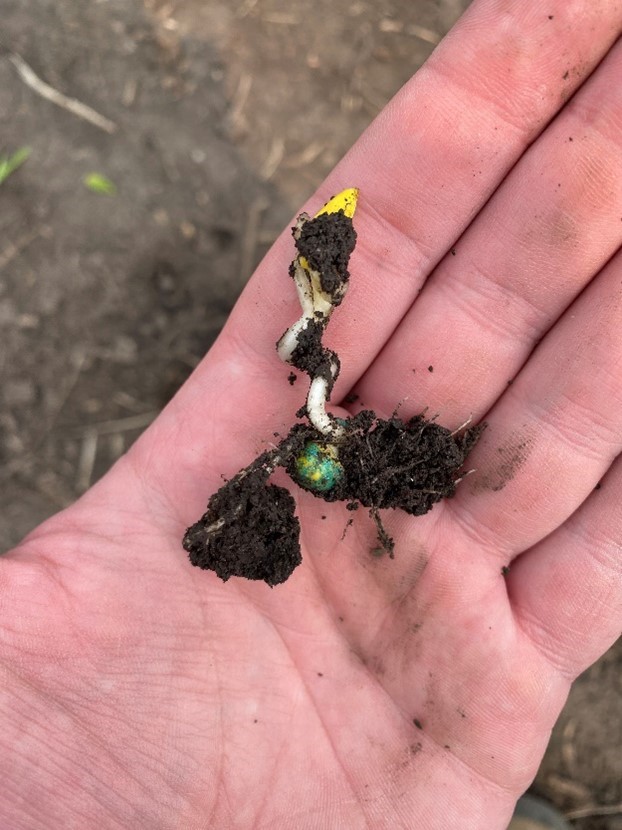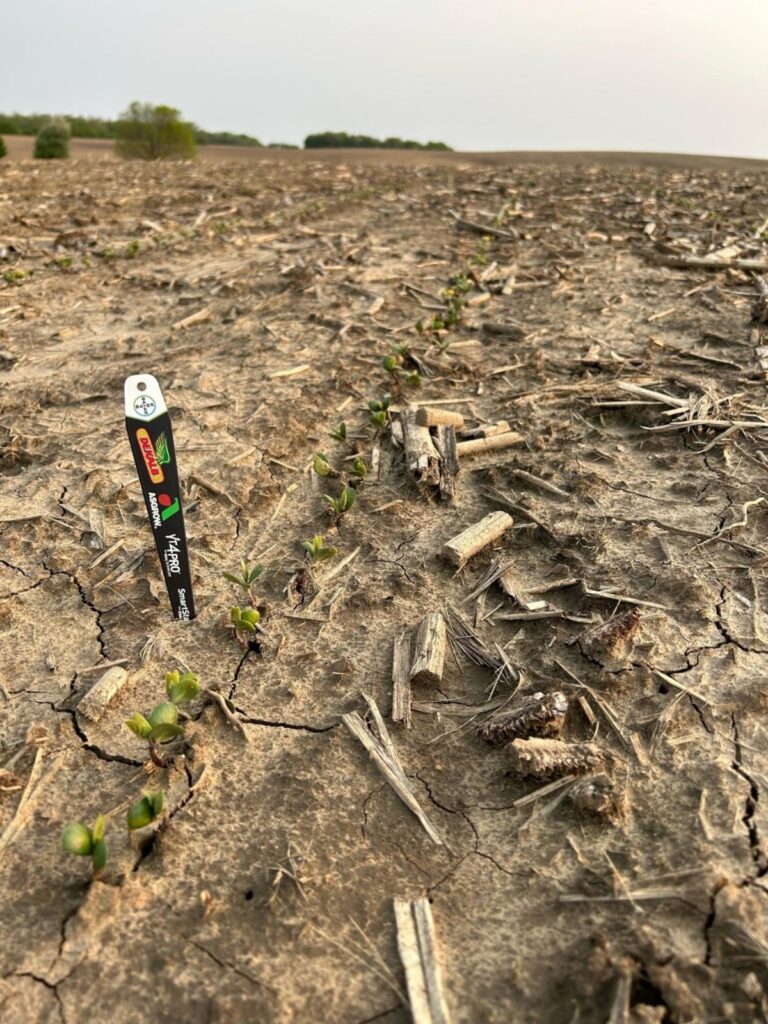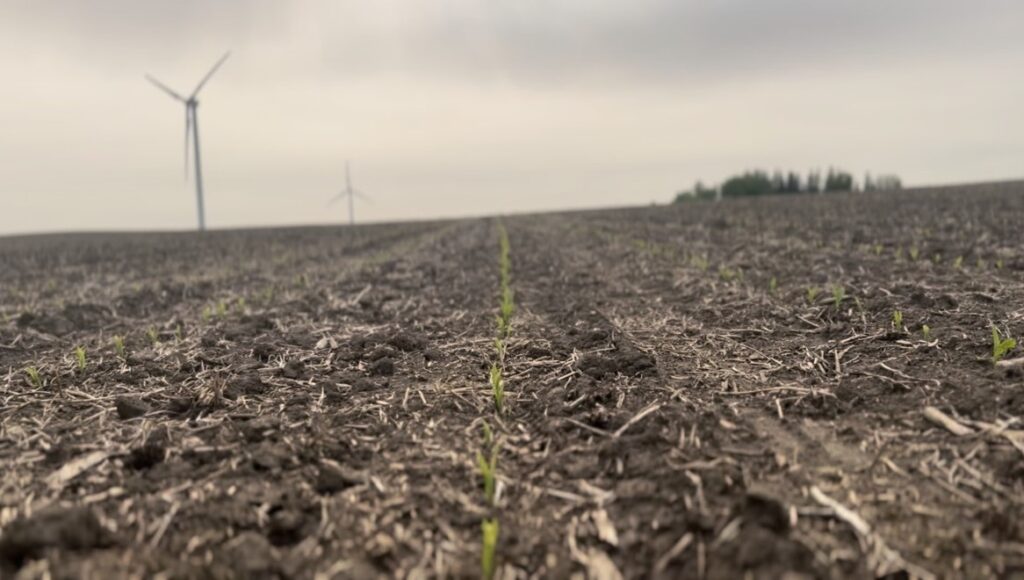
Week of May 15, 2023
The one-stop-shop for everything you need to know about what’s happening this week in your fields.
This week’s featured agronomists are:
Adam Steffel – Belle Plaine
Zach Hinsch – Wanamingo
Todd Anderson – Goodhue
Tye Anderson– Lewiston
Kristen Bauer – Ellsworth
Scroll down to hear from your local agronomist, and click for contact info!
WEST
Belle Plaine – Le Center – Le Sueur
 Adam Steffel
Adam Steffel
With the recent rains and warm weather, the crops are starting to come out of the ground fast. As the crop emerges it is a good time to get out into the field and scout to see what’s going on. The first thing you’ll notice is how even the stand is. Measure off 1/1,000th of an acre and take a stand count to make sure it’s close to what your intended planting rate was set to. If there are some plants missing, then it’s time to dig down and see what’s going on. In a few fields in the area, we have been seeing some corkscrewed corn plants and leafing out underground. This is most likely caused by the temperature fluctuations we’ve experienced and the cooler nights we’ve seen in the past couple weeks. If you see any problems out in your field, make sure to contact your local Ag Partners agronomist to help figure out what could be going on.

Corkscrewed corn plan

Utilize the chart below to measure off 1/1000th acre at various row widths
CENTRAL
Morristown – Wanamingo – Kenyon
 Zach Hinsch
Zach Hinsch
Off and rolling again this week. Mother nature has kept most of the planters in our area out of the field for a good 10-day stretch. Almost all fields corn and soybeans that were planted before the rain have emerged. As we are seeing our corn and soybeans emerging so are the weeds. Pictured below (left) is a soybean field planted on May 4th and sprayed with 5 oz Authority First + 1 pt Dual Magnum on May 5th. Emergence is looking awesome and the herbicide applied will keep weeds under control until our post pass. Also pictured below (right) is a corn field planted the same day (May 4th), with a preplant fertilizer applied, but no residual herbicide. We have some great products in our wheelhouse to keep these weeds under control season long, ensuring we are not losing bushels to competing weeds in the field. Have a great rest of your spring!
 Pre-emerge applied |
 …versus no pre-emerge |
EAST
Pine Island – Cannon Falls – Goodhue – Lake City
 Todd Anderson
Todd Anderson
Mother Nature has been testing our patience this spring to say the least. With it raining every 3rd or 4th day, it’s been a challenge to get the planter through the field. It’s important to stay patient at this point; almost everyone has the capability to plant ALOT of acres in a day so you should continue with the original plan to get maximum yield. Also keep in mind that fertilizer and spraying can all be done after you have planted.
Late planting considerations for corn:
In Minnesota it is usually recommended to stay with the original planned maturities until May 20 to 25. After this date the following guidelines should be followed:
- May 25 – 31 Plant hybrids 5 to 7 relative maturity units earlier than full season
- June 1 – 10Plant hybrids 8-15 relative maturity units earlier than full season
- June 11 – 15Plant hybrids 15 relative maturity units earlier than full season
It is still advantageous to select the fullest maturity, under the previous listed guidelines, to maximize the remaining yield potential of this crop. This is especially true this year with high commodity prices. It has also been proven that later planted corn does not take the full amount of GDD’s to reach physiological maturity as the same corn planted earlier in the season.
SOUTH
Elgin – Lewiston – Stewartville
 Tye Anderson
Tye Anderson
Southeast Minnesota weather has really shown off its versatility in the last five weeks. From 80-degree weather, to snow, to cold, then warm again, cold once more, and finally decent temperatures. We have been lucky to catch rain all the way through this process. Believe it or not this is a recipe for evenly emerged stands across the Lewiston geography.

As I look at this year vs. last year, I like to compare the similarities between the two. The one that really stands out to me is the weekly (daily at some locations) rains we have been receiving. I wrote an agronomic update last fall about crown rot(fusarium) impacting a large portion of our geography as a secondary disease to tar spot. The weather patterns we have experienced are indicative of similar issues we saw last fall with crown rot. You can dig roots and look for reddish-brown lesions on the mesocotyl to identify whether you have fusarium infected corn. I wish everyone a safe and productive remainder of spring!
Wisconsin
Ellsworth

Kirsten Bauer
Spring has sprung and as tractors and planters have covered the fields throughout the state of WI, this 2023 crop season has been no hill for a climber. The precipitation has been a challenge leaving only a handful of days truly suitable for fieldwork. As of Monday the USDA crop progress report claims about 30% of corn, and 18% of soybeans to be planted in our region of the state. We’ve begun to see seedling emergence here and there, showing us some light at the end of this soggy tunnel- but we aren’t in the clear just yet. As we inch towards the finish line with planting, don’t forget to scout those plants that are racing to emerge. Early season pathogens like Pythium and Fusarium especially favor wet soils. While seed treatments are a great defense; the residual control can be limited by soil conditions, and effectiveness can vary depending on the species present. Be sure to consult with your local Ag Partners Agronomist on any questions and concerns. Wishing you a safe and happy planting season!



